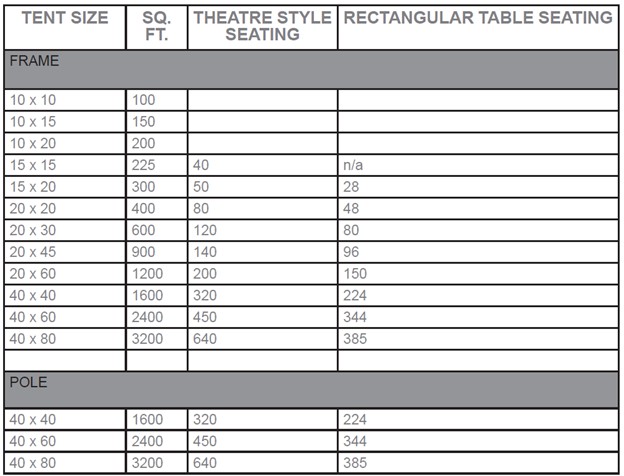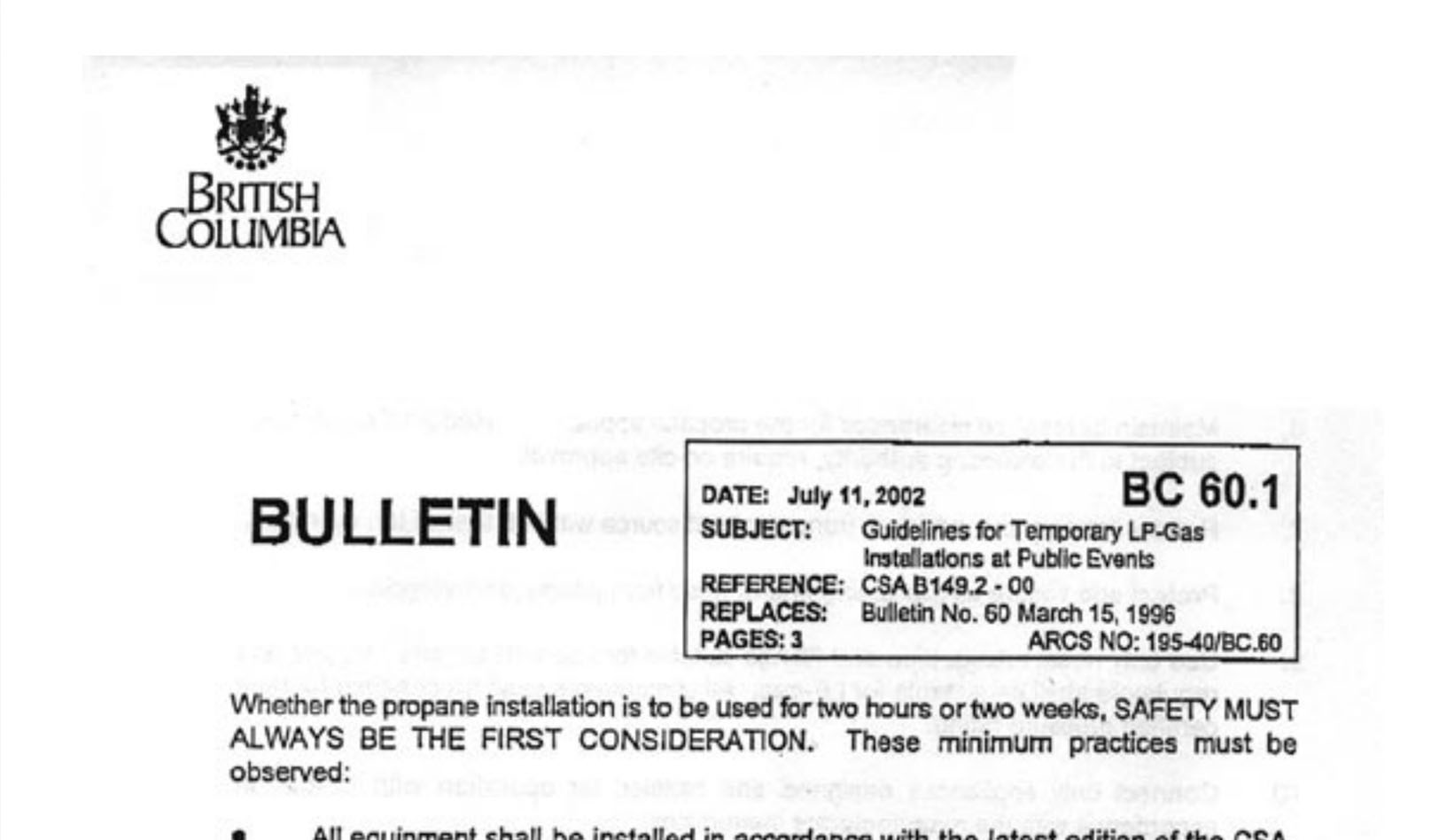Overview
When planning any activity requiring the use of a tent that will be occupied by people, the first step is to conduct a risk assessment. The risk assessment will help identify how much space you need and help identify risks associated with flammables (i.e. hair/makeup, costumes, paints, food services, clothing racks, etc.) The risk assessment will also help determine how much additional space you require for seating and the type of heating that will be safe to use.
Tent Selection Use and Placement
Consideration should also be given to planned use of the tent for:
- production and non-production purposes
- duration of intended use
- expected weather conditions
- topography

Minimum recommended space for seating. Remember to add space for specialized activities and consider issues such as location, availability of electricity, fueling logistics.
For example: If you are planning to seat guests at 8’ banquet tables (8 people per table), plan on 80 sq.ft. per table, plus space for specialized activities such as costume storage, storage of background performers’ personal belongings and/or food preparation.
Selecting a Heat Source
In the film industry, forced air, electrical and direct-fire propane are the most commonly used types of heaters.
Electrical
Electrical heaters do not give off any exhaust, so this eliminates the risk of carbon monoxide poisoning. However, the heaters can be an ignition source if flammables are present. Read and follow the manufacturer’s recommendations at all times.
Forced air with ducting and Direct-fire Propane
There are two types of forced air units in common use. One runs on diesel, propane, liquified natural gas or kerosene, with an electric fan. The unit is placed outside the tent and stack vented into the air, with a ducting that may be run into the tent or building. The other forced air unit has a coil that is heated by electricity, and an electric fan to blow the warmed air where required. The entire unit is sometimes placed directly inside the tent. Depending on the unit, the casing acts as an insulator, and the outside is not hot to the touch. When placing forced air outside a tent, careful consideration should be given to the placement of the exhaust to minimize potential entry into the tent.
Direct-fire propane heaters with single and double burners are often used in tents. It is important to ensure that it is safe to have an ignition source inside the tent and adequate ventilation must be maintained. Two openings directly to the outdoors MUST be provided, one high and one low, on opposite sides of the area to be heated. Each opening must be at least 7.72 centimetres (3 inches) for every 1000 btu. Therefore, for one 50,000 btu heater, two openings of at least .093 square metres (1 square foot) at each end are required. Workers must be trained in the safe use of all heaters and manufacturer’s instructions followed. Manufacturer’s instructions should be easily accessible for anyone working with or around propane. Defective or dysfunctional equipment should be taken out of service and returned to the owner for repair or replacement.
- BC Safety Authority regulations require appliances to bear a current decal, valid for 2 years, applied by a gas fitter certifying as to its safety and operaton. [am. B.C. Reg. 327/2005, Sch. 3, s. 1.]
- When setting up a portable propane heater, it is important to keep them clear of entrances and exits. Ensure that all flaps (from tent or temporary change rooms) are secure and/or out of the flammable range of the heater.
- The use of carbon monoxide detectors in a tent using direct-fired propane heaters or any combustible operation can prevent accidental exposure to cast and crew. Never close the flaps unless there is adequate ventilation from above and below the tent walls. Carbon monoxide is a potentially deadly, colourless, odourless gas that is present in most exhaust. Carbon dioxide is also a product of combustion and respiration.
- When a tent is installed by the rental company it is important to inspect all connections, anchor systems and the positioning of the heaters to ensure they have been installed in a safe manner.
- Wall tents sold in Canada must be treated with a fire retardant rated to CPA1-84. Inspect the tent(s) to ensure there is a label indicating the fire retardant status/rating.
Securing Propane
All tanks must be secured to the ground or other stable object. Smaller tanks may be placed inside an empty square milk carrier to ensure stability.
Activities in Tents
Many products used by hair, makeup and catering personnel are highly flammable. Direct-fired propane heaters or heaters with electrical elements should not be used in tents where hair and make-up or any other flammable aerosols, combustible gas or air borne particulate is present (such as paints or glues) due to the risk of combustion. For tents where hair and make-up will be applied, Actsafe recommends forced air heaters – units in which the ignition sources are outside of the tents and warm air is blown in via an air duct.
Aisles
Aisles should be kept clear and made wide enough for safe evacuation in the event of an emergency.
Some tents have a strip of material on the bottom of entrances/exits. These strips can pose a trip hazard. It is recommended that these be secured, marked or covered to prevent falls.
Fire Extinguishers
- NFPA regulations require a minimum of a Class ‘A’ fire extinguisher available in tents, and a B or C, depending on activities and size. Actsafe recommends having an ABC extinguisher available in tents to ensure that minimums are met regardless of activities taking place
- Maximum distances: Class ‘A’ fire extinguisher – 75 feet (22,86 metres), Class ‘B’ 30 or 50 feet (9.14 or 15.24 meters), depending on the type of hazard (low moderate or high) and the extinguisher rating. Source: NFPA 10, 2002 edition Table 5.3.1
Other Issues for Consideration
- Will a permit be required?
- Consider the location of the tent: is the ground high and solid?
- Observe anchoring specifications found in the manufacturer’s instructions.
- Tent condition: If tents are showing signs of mold (black or discoloration up the sides) or other damage, do not use the tent. Return it and report to the owner or rental company so that it can be cleaned, repaired or replaced.
- Smoking is prohibited inside tents under the Regulation (see: http://www2.worksafebc.com/ publications/OHSRegulation/Part4.asp#SectionNumber:4.81).
For information on the safe set-up and use of small tents up to 60 m2 (645 ft), please refer to:
Actsafe’s Performing Arts Bulletin #12 at: https://www.actsafe.ca/wp-content/uploads/2017/11/Small-tents-Performing-Arts-Bulletin-PDF.pdf
For more detailed information on the use of propane, Actsafe’s safety guideline is available online at: https://www.actsafe.ca/topic/propane/propane-guidelines-motion-picture-fact-sheet/



Share Now: